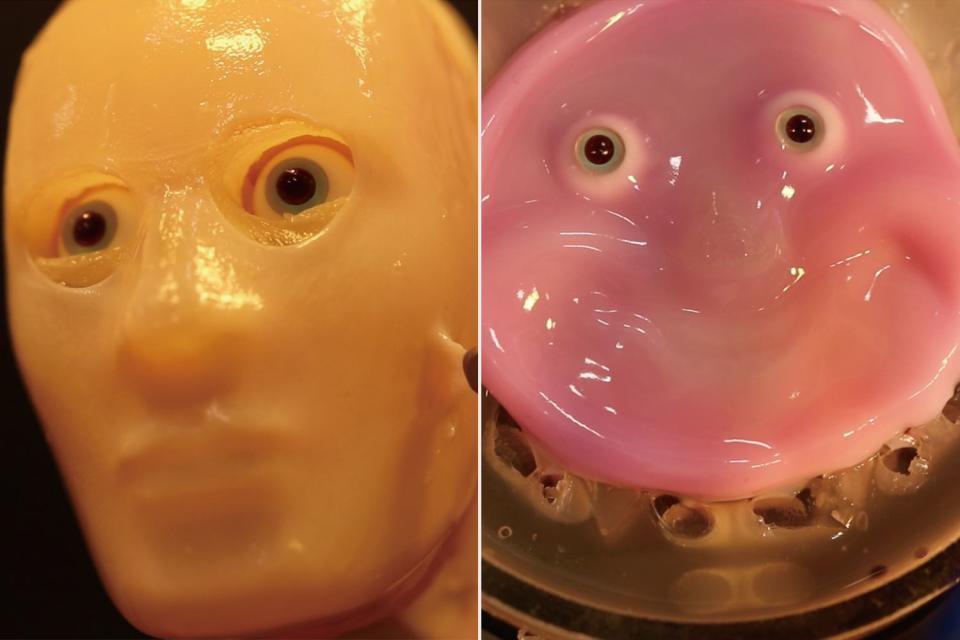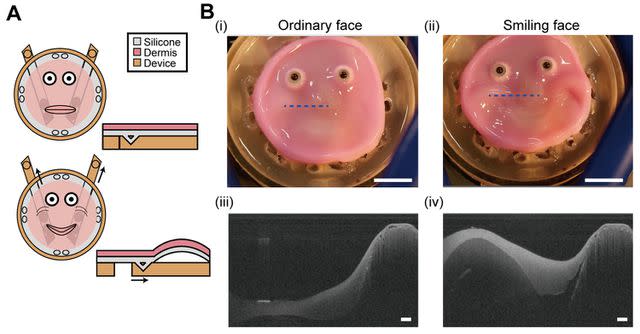Japanese Scientists Create Smiling Robot with 'Living' Skin Using Collagen
A team of researchers at the University of Tokyo successfully bound engineered skin tissue onto the face of a humanoid robot

The University of Tokyo
A research lab at the University of Tokyo created a robot with human skinRobots with human-like skin may be closer to reality than one might think.
On Wednesday, June 26, a team of researchers at the University of Tokyo announced that they successfully bound engineered skin tissue onto the face of a humanoid robot.
Professor Shoji Takeuchi, who specializes in Biohybrid Systems and led the group of researchers, has also created small robots that use biological muscle tissue to move along with three-dimensionally printed lab-grown meat.
With this latest experiment, the research team created a flesh-like material that can adhere to a robotic finger and bend without breaking, similar to that of a human. They took the "living" skin and applied it to a robot with light glassy eyes. And yes, it can also smile.
“During previous research on a finger-shaped robot covered in engineered skin tissue we grew in our lab, I felt the need for better adhesion between the robotic features and the subcutaneous structure of the skin,” Takeuchi said in a press release, explaining how the idea for the "living" skin came to be.
The PEOPLE Puzzler crossword is here! How quickly can you solve it? Play now!

The University of Tokyo
Diagram of the creation of 'living' skin“By mimicking human skin-ligament structures and by using specially made V-shaped perforations in solid materials, we found a way to bind skin to complex structures," he continued.
Previously, small hooks or anchors were used to attach skin tissue to solid surfaces.
Never miss a story — sign up for PEOPLE's free daily newsletter to stay up-to-date on the best of what PEOPLE has to offer, from celebrity news to compelling human interest stories.
For adhering the skin tissue to the robot, the research team used a special collagen gel, which is strong enough to withstand perforations. The scientists were able to mold the collagen onto a robot and cling closely to the surfaces, making for a malleable material.
The researchers were ultimately able to successfully place the "living" skin onto surfaces, but there are bigger implications at stake beyond the smiling robot face becoming nightmare fuel.
According to a press release, this latest experiment could lead to robots with "increased mobility, self-healing abilities, embedded sensing capabilities and an increasingly lifelike appearance." It could also be beneficial to training plastic surgeons.
In time, this "living" skin could lead to breakthroughs in research related to skin aging, cosmetics, surgical procedures, plastic surgery and drug development.
Overall, Takeuchi is thrilled with the outcome of the experiment. "Creating robots that can heal themselves, sense their environment more accurately and perform tasks with humanlike dexterity is incredibly motivating.”
For more People news, make sure to sign up for our newsletter!
Read the original article on People.


